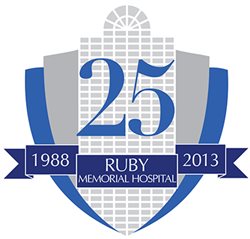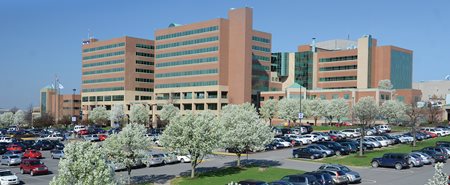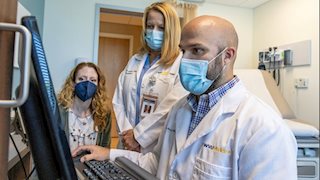Attention reporters and editors: If you would like to cover the employee appreciation picnic, which will be held from 11 a.m. to 3 p.m. in the west concourse of Milan Puskar Stadium, please contact Angela Jones-Knopf at 304-293-7087 in advance.
MORGANTOWN, W.Va. – One day earlier this month, 458 overnight patients were being cared for at WVU Healthcare’s Ruby Memorial Hospital. That’s the highest census the hospital has recorded since it opened on July 19, 1988. Hundreds of other patients were treated the same day at the hospital’s outpatient clinics, same-day surgery center and Emergency Department.
 This Friday, hundreds of hospital employees and medical staff will gather at a picnic on the 25th anniversary of the hospital to kick off a celebration that will last into the fall, marking a quarter century of care for tens of thousands of patients.
This Friday, hundreds of hospital employees and medical staff will gather at a picnic on the 25th anniversary of the hospital to kick off a celebration that will last into the fall, marking a quarter century of care for tens of thousands of patients.The building – a replacement for the original University Hospital next door – had several unique features: WVU Children’s Hospital was integrated into the facility, occupying the entire sixth floor; the Jon Michael Moore Trauma Center; and a rooftop helipad, still in daily use by HealthNet, allows patients to be taken swiftly from the aircraft to the Emergency Department, or directly to the surgical floor by elevator.
Ruby Memorial Hospital has grown and changed through the years. It’s currently under construction once more, as part of a multimillion-dollar expansion of health facilities on and off campus to serve the growing population of the region. But its missions remain the same as in 1988: caring for patients, training health professionals and advancing scientific research.
A gift that changed the campus: Hazel Ruby McQuain gift energized construction plan
The original University Hospital had little history of private support. Built with funds from the pop tax, its operations were funded almost entirely by patient revenues and the state budget. As a major provider of care to uninsured patients, its budget was always thin, with little or no funds available to upgrade equipment or improve services.
.jpg) One gift changed the picture for the new hospital. Hazel Ruby McQuain was a Morgantown resident, who, with her late husband, J.W. Ruby, had operated a plumbing supplies factory in Morgantown’s Sabraton neighborhood for a generation. She pledged $8 million toward the new hospital, an amount that stunned the University community and spurred other donors into action.
One gift changed the picture for the new hospital. Hazel Ruby McQuain was a Morgantown resident, who, with her late husband, J.W. Ruby, had operated a plumbing supplies factory in Morgantown’s Sabraton neighborhood for a generation. She pledged $8 million toward the new hospital, an amount that stunned the University community and spurred other donors into action.That donation, along with several others from individuals and businesses across the state, provided a significant piece of the $87 million cost of building the new hospital. The hospital corporation was able to finance the rest without seeking any state funds.
Hazel Ruby McQuain took an active interest in the hospital that bore her family’s name. She was there to help escort the first patient who transferred from the old hospital to the new one; created endowments in the School of Medicine to honor a pioneering University physician, Dr. Edmund Flink; and showed up regularly at hospital events to chat with nurses, doctors, and administrators about how things were going. During the remainder of her life, she continued to make substantial gifts to support students in WVU health programs, renovations to Health Sciences Center facilities, stroke and cancer research and care, and WVU Healthcare’s Rosenbaum Family House. She established a charitable trust which continues to support programs at WVU and across the state.
The Ruby gift marked a watershed moment for philanthropy at West Virginia University. It spurred a healthy competition among the state’s more fortunate citizens to make significant contributions, many of which made possible additional facilities, including specialized areas for children’s care and cancer patients. It also opened the door to thousands of smaller donors – including grateful patients, civic organizations, schoolchildren and others whose gifts added up to hundreds of thousands of dollars each year.
A $60 million headache: Original University Hospital, built in 1960, closed in 1987
In the early 1980s, West Virginia University’s on-campus hospital was a mess.
University Hospital wasn’t very old. Opened with great fanfare in the summer of 1960, financed by a penny-a-bottle tax on soft drinks, the hospital was supposed to last for generations. It barely made it through one.
The structure was solid. It still stands today as the south wing of the Health Sciences building. But the inner workings of the building were far out of line with hospital safety and operational standards. A smoky fire in 1967 drove patients and staff from the building – and demonstrated that the hospital lacked basic fire safety features. Repeated requests to state and University officials for funds to upgrade the hospital fell on deaf ears.
In 1983, a ventilation breakdown sent soot and debris into the air vents supplying much of the hospital, including all but one of the hospital’s eleven operating rooms. Other hospitals around the state had to take WVU patients for up to three weeks as the University scrambled to patch the problem.
The estimated cost of meeting health and safety standards was estimated to approach $60 million – and the state didn’t have the money.
University officials, led by President Gordon Gee, floated a novel plan: turn the state-owned hospital over to a new, non-profit corporation that could borrow money to build a replacement hospital, and pay it back out of future revenue.
Not everyone thought it was a good idea. University faculty members and others objected to replacing a hospital
 that was just two decades old, and to the idea of turning one of the state’s most expensive facilities over to a private group, even a non-profit headed by the University president.
that was just two decades old, and to the idea of turning one of the state’s most expensive facilities over to a private group, even a non-profit headed by the University president.But for Jay Rockefeller, the state’s Governor, the economics of the plan were hard to dispute. Instead of facing a massive repair bill to fix up an old hospital, he’d be able to let WVU build a new hospital without dipping into the state budget. Legislators agreed – and by the middle of 1984, the state handed the decaying hospital over to the new WVU Hospitals corporation.
The plan worked; the new hospital was up and running four years later. And the concept of having a privately-run nonprofit hospital on a University campus was widely adopted elsewhere. WVU Hospitals later formed the nucleus of the West Virginia United Health System, also created by the legislature, which now includes hospitals in four other West Virginia communities.


